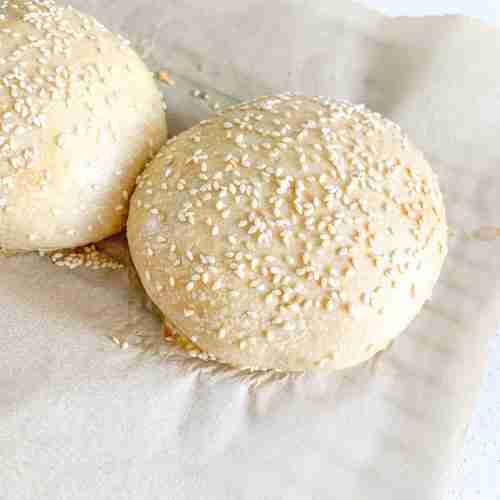
Sourdough Hamburger Buns (easy small batch recipe)
This sourdough hamburger bun recipe is perfect if you're looking to make a small batch! My easy recipe makes 3 buns, but you can double it as many times as you'd like. The steps are simple, and the ingredients are wholesome. I hope this recipe replaces store-bought hamburger buns in your house like is has in ours!
Ingredients
The Buns
- 1 1/2 cup all-purpose flour
- 1 tsp sea salt
- 1/4 cup fed sourdough starter
- 1/2 cup water
- 1 1/2 Tbsp avocado oil (or melted butter)
The Topping
- egg wash (1 egg + 2 Tbsp water)
- sesame seeds (optional)
Instructions
- BEFORE YOU GET STARTED: Feed your entire sourdough starter jar 4-12 hours before starting this recipe. I recommend feeding your entire starter a 2:1 ratio of unbleached flour to filtered water to get the same results as I do when making this recipe.(Example: Feed entire starter 1 cup flour + 1/2 cup water and let it sit on the counter at room temperature until it's bubbly and has grown in the jar. Your starter needs to be active, bubbly, and a thicker consistency to use in this recipe.)
Make the Dough
- Add the starter, salt, water, avocado oil, and flour to a mixing bowl and mix until combined.
- Knead for 2 minutes (by hand or with an electric stand mixer with a kneading attachment).
- Place the dough back into the bowl and cover loosely with a wet towel or lid slightly on (not airtight).
Bulk Ferment
- Let the dough bulk ferment on the counter for 10-12 hours. It should double in size and be full of air bubbles. See notes below!
- Optional: When the bulk ferment is over you can continue this recipe OR cover the dough with an airtight lid or saran wrap. Then place it in the fridge up to 48 hours until you're ready to use it.
Shape Buns
- Turn the dough out on the counter (no flour needed). Divide dough into 3 equal pieces.
- Roll each dough piece into a ball, then press down gently to create a dome shape (flat bottom).
- Place each bun on a parchment-lined sheet pan about 2 inches apart.
Proof and Bake
- Cover the sheet pan with a dry towel and let the buns rise at room temp for 2-4 hours. They should be puffy and larger after the proofing. See notes below!
- Preheat oven to 375 degrees Fahrenheit.
- Brush buns with egg wash and sprinkle on sesame seeds if desired. Bake for 20–25 minutes.
- Take out of oven and place on a cooling rack. Enjoy!
Video
Notes
What to do if your dough isn't doubling in size during the bulk ferment and/or 2nd rise:
- If your dough doesn't look like it's doing anything halfway through the rises, you need to place it in a slightly warmer area.
- This can be in a turned-off oven with the light on and oven door open, or you can slightly warm the oven to about 75-80 degrees Fahrenheit, then turn it off and place your dough inside with the door shut.
- Never leave the oven on, even on the keep warm setting, with fermenting dough inside. Your dough, for both rises, needs to double.
- If your dough doesn't double even in the warmer area, there is a problem with your starter. It is too weak to ferment the dough even in a warm environment.
- To fix this, you will want to leave your starter out on the counter for 2 days and feed it every 12 hours at a 2:1 ratio of unbleached flour to filtered water.
- For example, 1 cup unbleached flour + 1/2 cup filtered (or bottled) water.
- Make sure you're using unbleached flour and filtered or bottled water to do this. If you don't, it will affect your starter strength. Reverse osmosis water (or any water that uses salt in the filter) can make the starter weak.
- This will strengthen the cultures in your starter to give you fluffy baked bread and treats. After the 2 days, you can go back to feeding it like usual (once a week if stored in the fridge or once a day if stored on the counter). Be sure to use the 2:1 ratio feeding from here on out.